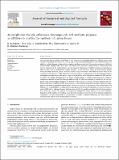Por favor, use este identificador para citar o enlazar a este item:
http://hdl.handle.net/10261/260417COMPARTIR / EXPORTAR:
 SHARE SHARE
 CORE
BASE CORE
BASE
|
|
| Visualizar otros formatos: MARC | Dublin Core | RDF | ORE | MODS | METS | DIDL | DATACITE | |

| Título: | An insight into the role of biomass, biocompounds and synthetic polymers as additives to coal for the synthesis of carbon foams |
Autor: | Rodríguez Vázquez, Elena CSIC ORCID ; Díez Díaz-Estébanez, María Antonia CSIC ORCID ; Antuña-Nieto, Cristina CSIC ORCID CVN ; López Antón, María Antonia CSIC ORCID ; García Fernández, Roberto CSIC ORCID; Martínez Tarazona, María Rosa CSIC ORCID | Palabras clave: | Carbon foams Co-pyrolysis Fluidity Porosity Thermal conductivity Thermogravimetry |
Fecha de publicación: | 1-nov-2021 | Editor: | Elsevier | Citación: | Journal of Analytical and Applied Pyrolysis 160: 105359 (2021) | Resumen: | Carbon foams were synthesized from blends of coal and several C-containing additives of different nature, with the aim to study their influence on the foaming step, and hence in the final properties of the obtained foams. The additives included biomass and agricultural products, and thermoplastic and thermosetting polymers, at different concentrations, ranging from 5 to 20 wt%. The effects of the additives on pore structure, carbon matrix and thermal properties of the resulting foams were investigated. The presence of additives during pyrolysis had no effect on the yield of carbonaceous product. However, all the additives, except the polybutadiene phenyl terminated (PBP) elastomer, led to a reduction in the fluidity of the blend. This difference in the effect can be related to the liquid nature of PBP, which favors the impregnation of coal particles, to the decomposition pattern overlapping with that of the coal, and to a high chemical affinity of the degradation products of PBP and coal. Analysis of the fluidity development of the blends and the changes in volatile matter production at different temperature intervals showed that bio-type additives with the maximum emission of volatiles in the coal pre-plastic stage provided improvements in the porosity of the C-foams. In contrast, synthetic polymers like low-density polyethylene (LDPE) and PBP generated most of their thermal degradation products during the plastic and the own thermal degradation stages of coal, leading to a reduction in the porosity of the carbon foams. This behavior can be attributed to a blocking of some macropores in the C-foams by deposition, in the pore mouths, of molten LDPE and/or oligomers from its backbone promoted by the conditions applied during the long residence time inside the reactor. The addition of polyethylene terephthalate (PET) resulted in no foam formation. Regardless of the additive, the resulting foams derived from binary blends showed lower thermal conductivity compared to that synthesized from the unmixed coal. The values of thermal conductivity are closely related to the porous and carbon structure displayed by the foams. | Versión del editor: | https://doi.org/10.1016/j.jaap.2021.105359 | URI: | http://hdl.handle.net/10261/260417 | DOI: | 10.1016/j.jaap.2021.105359 | ISSN: | 0165-2370 |
| Aparece en las colecciones: | (INCAR) Artículos |
Ficheros en este ítem:
| Fichero | Descripción | Tamaño | Formato | |
|---|---|---|---|---|
| Insight_role_biomass_Rodriguez.pdf | 3,51 MB | Adobe PDF |  Visualizar/Abrir | |
| Insight_role_biomass_Rodriguez_SI.pdf | Supplementary information | 528,88 kB | Adobe PDF |  Visualizar/Abrir |
CORE Recommender
SCOPUSTM
Citations
6
checked on 25-may-2024
WEB OF SCIENCETM
Citations
6
checked on 28-feb-2024
Page view(s)
51
checked on 28-may-2024
Download(s)
88
checked on 28-may-2024
Google ScholarTM
Check
Altmetric
Altmetric
Este item está licenciado bajo una Licencia Creative Commons

